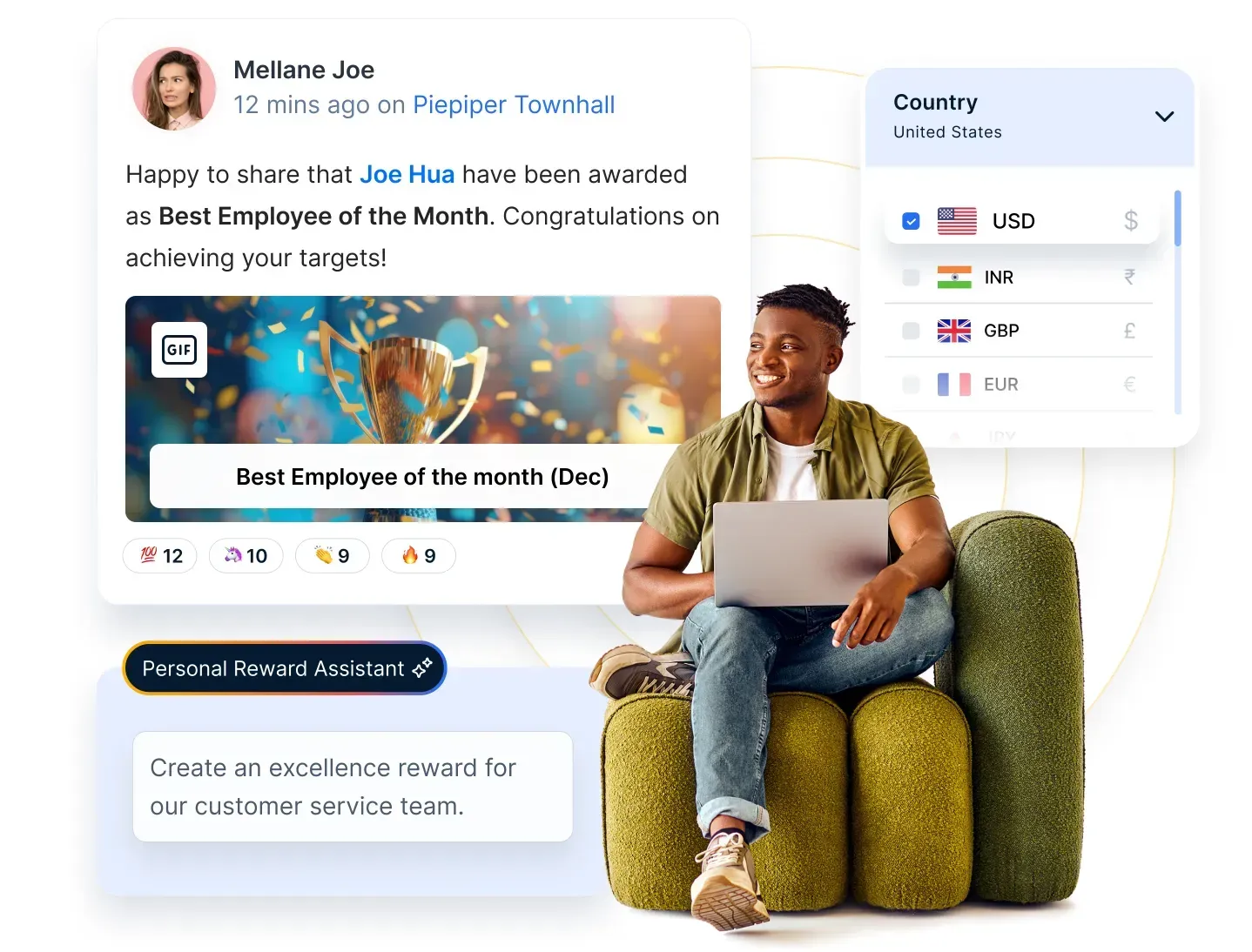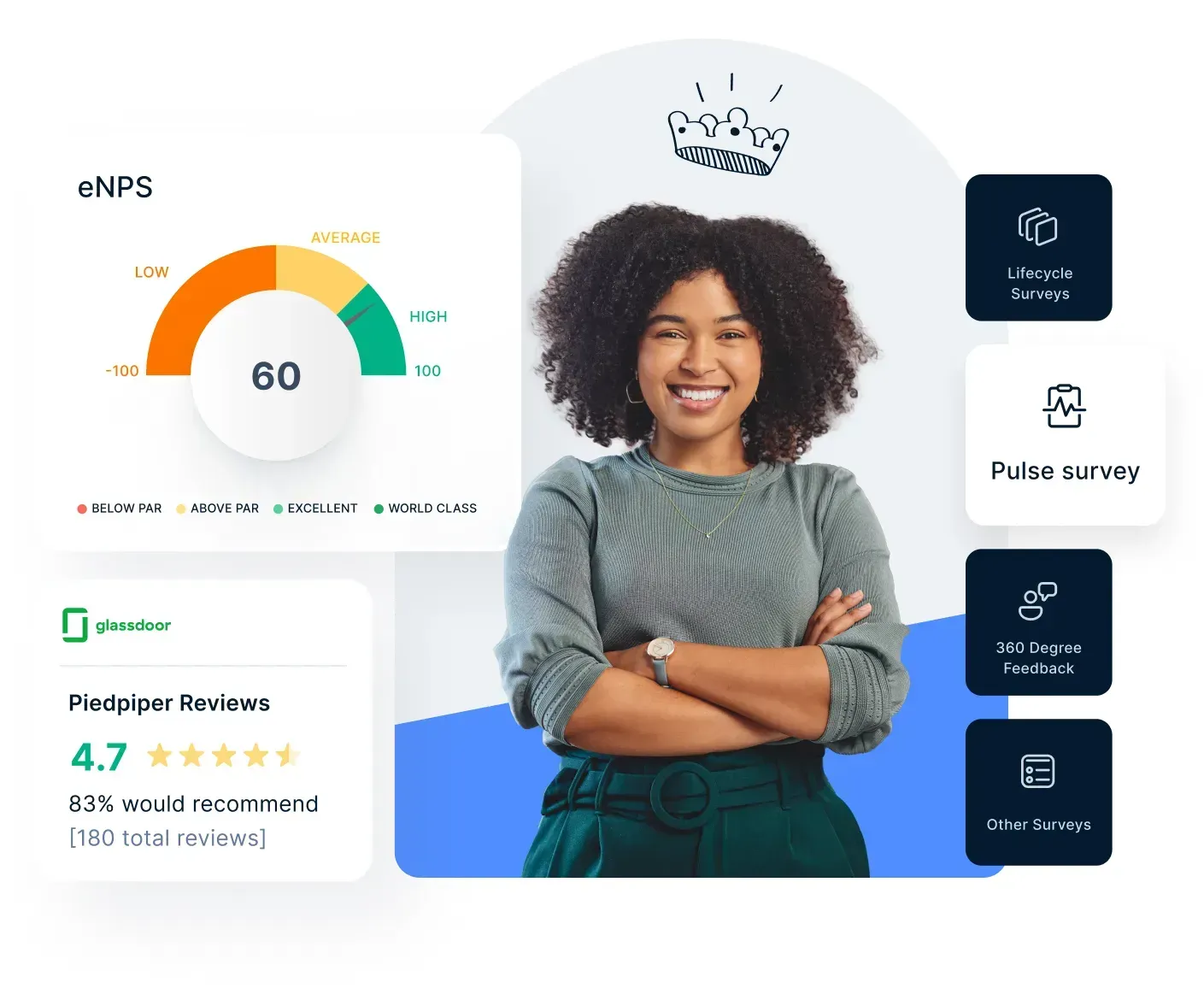Come migliorare la fidelizzazione dei dipendenti: 13 modi creativi per fidelizzarli
Scoprite come migliorare la fidelizzazione dei dipendenti affrontando le sfide principali, migliorando il coinvolgimento e creando un ambiente di lavoro che i dipendenti amano.
In questa pagina
- Che cos'è la fidelizzazione dei dipendenti?
- Sfide per la fidelizzazione dei dipendenti
- Come calcolare il tasso di fidelizzazione dei dipendenti?
- Come migliorare la fidelizzazione dei dipendenti: 13 strategie più efficaci
- Lista di controllo per il monitoraggio della retention dei dipendenti
- Rafforzare la fidelizzazione dei dipendenti con Empuls
- Conclusione
Uno dei maggiori problemi per le aziende è il miglioramento della fidelizzazione dei dipendenti. Secondo i dati dell'Ufficio delle statistiche del lavorotra luglio e novembre 2022, più di 4 milioni di americani hanno lasciato volontariamente il posto di lavoro.
A conferma di questo studio, Gartner ha rivelato che il settore delle imprese potrebbe registrare un tasso di turnover del 24% negli anni a venire, il che impone alle organizzazioni di adottare migliori strategie di fidelizzazione dei dipendenti.
I dipendenti sono considerati il bene più importante per un'organizzazione, e il secondo sono i clienti. Se vi occupate con cura dei vostri dipendenti, essi rifletteranno questo sentimento ai vostri clienti, distinguendovi dal resto del mercato. La chiave di tutto questo è il coinvolgimento dei dipendenti.
A studio Gallup ha dimostrato che le organizzazioni con dipendenti altamente impegnati possono registrare una redditività superiore del 21%, il che richiede l'attuazione di strategie di fidelizzazione dei dipendenti collaudate. Prendiamo ad esempio grandi marchi come Facebook, Amazon, TATA e Google. Sono solo alcuni esempi di organizzazioni che hanno una cosa in comune: assumono talenti e li trattengono.
Nel mondo competitivo di oggi, i lavoratori altamente qualificati possono sentirsi costretti a cambiare lavoro se ricevono un'offerta migliore. Un dipendente che non si sente coinvolto e rispettato o che non progredisce nella vostra azienda inizierà a cercare altre opzioni migliori.
Desiderate ridurre il turnover del personale e migliorare la produttività. In questo caso, la creazione di una strategia efficace di fidelizzazione dei dipendenti dovrebbe essere una priorità assoluta nella vostra lista di cose da fare.
Che cos'è la fidelizzazione dei dipendenti?
La fidelizzazione dei dipendenti comprende gli sforzi complessivi di un'organizzazione per evitare che i suoi dipendenti se ne vadano. Da una prospettiva più ampia, si tratta di costruire un ambiente in cui i dipendenti sperimentino le tre R fondamentali della fidelizzazione: rispetto, ricompensa e riconoscimento.
I programmi di fidelizzazione dei dipendenti possono variare a seconda di ciò che manca all'azienda. Ecco alcuni esempi:
- Implementazione di gruppi di supporto peer-to-peer o di consulenza gratuita.
- Integrazione di tecnologie AI come Generatori di immagini AI, creatori di slideshow AIo software di copywriting per automatizzare le attività e semplificare il lavoro.
- Configurazioni di lavoro flessibili e remote
- Mentoring inverso, in cui i dipendenti forniscono feedback ai loro superiori.
Costruite questi programmi con i valori fondamentali della fidelizzazione dei dipendenti e godete del vantaggio principale di una migliore esperienza dei dipendenti: l'assunzione di talenti di alto livello che restano nel paese.
Nel frattempo, c'è un rapporto Gallagher che prevede lo stato di conservazione dei dipendenti nel 2024. Il 57% delle organizzazioni prevede un aumento dell'organico. La fidelizzazione dei dipendenti rimane una delle principali priorità operative, evidenziando la necessità per le aziende di intensificare gli sforzi per evitare che i dipendenti se ne vadano.
Sfide per la fidelizzazione dei dipendenti
La fidelizzazione dei dipendenti va oltre la semplice offerta di uno stipendio. Le aziende devono affrontare le sfide principali che incidono sulla soddisfazione lavorativa, sul coinvolgimento e sull'impegno a lungo termine. Identificando questi ostacoli e implementando modi creativi per trattenere i dipendenti, le aziende possono costruire un ambiente di lavoro in cui i dipendenti si sentano apprezzati, motivati e desiderosi di rimanere.
1. Mancanza di opportunità di crescita professionale
I dipendenti spesso se ne vanno quando si sentono bloccati nello stesso ruolo senza un chiaro percorso di avanzamento. Le aziende che non offrono formazione, tutoraggio o promozioni rischiano di perdere i migliori talenti a vantaggio della concorrenza. I programmi di sviluppo professionale e i workshop per lo sviluppo delle competenze sono modi creativi per trattenere e mantenere i dipendenti impegnati.
2. Compensi e benefit inadeguati
Stipendi e benefit competitivi sono essenziali per la fidelizzazione dei dipendenti. Se i dipendenti si sentono sottopagati o se i loro benefit non soddisfano gli standard del settore, è più probabile che esplorino altre opportunità di lavoro. L'offerta di bonus basati sui risultati, programmi di benessere e vantaggi personalizzati può essere un modo creativo per trattenere i dipendenti e migliorare la soddisfazione sul lavoro.
3. Scarso equilibrio tra lavoro e vita privata
I dipendenti che lottano per mantenere un equilibrio tra lavoro e vita privata spesso vanno incontro a burnout. Orari rigidi, carichi di lavoro eccessivi e aspettative irrealistiche portano all'insoddisfazione e all'aumento del turnover. L'introduzione di modalità di lavoro flessibili, di opzioni di lavoro a distanza e di permessi retribuiti aggiuntivi può essere un modo creativo per fidelizzare i dipendenti e migliorare il loro benessere generale.
4. Mancanza di riconoscimento e incentivi
I dipendenti devono sentirsi valorizzati e apprezzati per il loro contributo. Quando le organizzazioni non riconoscono gli sforzi o non premiano i risultati, la motivazione e la fedeltà diminuiscono. L'implementazione di programmi di incentivazione, piattaforme di riconoscimento dei dipendenti e ricompense non monetarie sono modi creativi per trattenere i dipendenti e promuovere una cultura di apprezzamento.
5. Cultura aziendale e impegno deboli
Un ambiente di lavoro tossico, una leadership scadente e la mancanza di collaborazione tra i team possono allontanare i dipendenti. I dipendenti che non sentono un senso di appartenenza hanno meno probabilità di rimanere legati all'azienda. Incoraggiare la comunicazione aperta, promuovere l'inclusività e organizzare attività di team building sono modi creativi per trattenere i dipendenti e rafforzare la cultura del luogo di lavoro.
Come calcolare il tasso di fidelizzazione dei dipendenti?
Quando si parla di strategie di fidelizzazione dei dipendenti, le risorse umane devono adottare misure specifiche per tracciare le statistiche relative al tasso di fidelizzazione dei dipendenti. Una volta tracciate queste statistiche, si saprà quali iniziative si possono intraprendere per ridurre i tassi di retention dei dipendenti.
Il calcolo del tasso di retention dei dipendenti è semplice: Dividere il numero totale di dipendenti che hanno lasciato l'azienda durante un periodo per il numero totale di dipendenti alla fine del periodo per ottenere la percentuale.
Periodo: 3° trimestre
Numero totale di dipendenti all'inizio del 3° trimestre = 34
Numero totale di dipendenti che hanno lasciato il lavoro nel 3° trimestre: 4
Calcolo: 34-4 =30
Tasso di ritenzione dei dipendenti = Numero totale di dipendenti che hanno lasciato il lavoro durante un periodo
Numero totale di dipendenti alla fine di un periodo
Tasso di mantenimento dei dipendenti = 30 / 34 = 88%
Una ricerca del Center for American Progress afferma che il costo della sostituzione di dipendenti/dirigenti altamente qualificati può facilmente superare il doppio del loro stipendio annuale. L'obiettivo di ogni azienda è assumere personale di talento e farlo rimanere più a lungo.
La fidelizzazione dei dipendenti non è un lavoro facile. Un recente studio di Willis Towers Watson afferma che più della metà delle aziende a livello globale dichiara di avere difficoltà a trattenere alcuni dei propri dipendenti più stimati.

Trattenere i migliori talenti con un riconoscimento significativo
La fidelizzazione dei dipendenti inizia con l'apprezzamento. Utilizzate Empuls per creare una cultura di riconoscimenti, premi e impegno continui che mantenga i dipendenti motivati e impegnati.
Come migliorare la fidelizzazione dei dipendenti: 13 strategie più efficaci
Ecco alcuni consigli su come migliorare la fidelizzazione dei dipendenti. Alcuni di questi consigli potrebbero essere già noti, mentre altri potrebbero essere nuovi per voi, ma la cosa fondamentale è che tutti questi consigli vi aiuteranno a stimolare la fedeltà a lungo termine dei vostri top performer.
1. Analizzare i motivi per cui i dipendenti lasciano il lavoro
Se non sapete perché i dipendenti lasciano la vostra azienda, non potrete sviluppare una strategia efficace per farli rimanere.
Innanzitutto, analizzate il tasso medio di turnover del vostro settore: il vostro tasso di turnover dei dipendenti è superiore alla media?
L'implementazione di un processo di interviste di uscita per i dipendenti in uscita può fornire informazioni sulle vere ragioni per cui i dipendenti se ne vanno.
Dopo tutto, sono più propensi a essere onesti quando se ne vanno, e se non glielo chiedete voi, potrebbero dirlo al mondo intero in una recensione negativa su Glassdoor o su un altro sito.
Osservate gli schemi che vedete una volta che avete iniziato a raccogliere i dati. Ricevete feedback da più dipendenti su problemi di equilibrio tra lavoro e vita privata, problemi con i manager, problemi di cultura del luogo di lavoro, sviluppo di carriera bloccato o altro?
Cosa ostacola la vostra strategia di fidelizzazione dei dipendenti? Non si può risolvere un problema finché non lo si identifica.
2. Esaminare la strategia di assunzione
Tutto inizia con l'assunzione. Le persone che vi lasciano sono quelle che avete assunto. Per questo motivo, analizzate a fondo il vostro processo di assunzionetra cui i requisiti del lavoro, la descrizione delle mansioni, i processi di colloquio, la retribuzione e i benefit, i ruoli e le responsabilità.
E vedete un gran numero di dipendenti che si licenziano pochi mesi dopo essere stati assunti perché il lavoro non era quello che pensavano?
Le descrizioni delle mansioni devono essere uno sguardo onesto sulla cultura aziendale e una visione dettagliata e accurata delle responsabilità del lavoro.
I dipendenti non dovrebbero essere sorpresi dagli aspetti fondamentali del lavoro dopo l'inizio: ciò significa che è necessario modificare qualcosa nel processo di assunzione, in modo da assumere le persone giuste fin dall'inizio e creare le giuste aspettative.
3. Ottimizzare l'onboarding dei dipendenti
Il primo giorno in un nuovo posto di lavoro è spesso molto simile all'esperienza che abbiamo vissuto il primo giorno di scuola: il nervosismo, l'eccitazione di incontrare nuove persone, di imparare nuove cose e così via.
Se è impegnativo per i nuovi dipendenti familiarizzare con il nuovo ambiente, le persone, i processi, le responsabilità lavorative e così via, lo è altrettanto per i dirigenti.
Il manager ha la responsabilità di preparare il nuovo assunto al successo, facendolo sentire a proprio agio con l'organizzazione e il team fin dall'inizio (ben prima del suo primo giorno di lavoro!).
Un piano individuale intelligente e ben ponderato per ogni dipendente inserito può essere molto utile. Assicuratevi che i dipendenti non vengano solo informati sui ruoli e le responsabilità, ma anche sulla cultura aziendale e su come possono prosperare ogni giorno.
Preparate piani e obiettivi per la prima settimana, il primo mese, il primo trimestre e così via, in modo che sia chiaro cosa ci si aspetta.
Gesti come un annuncio sul portale intranet, la presentazione dei nuovi dipendenti, l'assegnazione di un compagno o di un mentore per aiutarli a superare i primi giorni possono avere un grande impatto.
In breve, l'esperienza l'esperienza di onboarding dei dipendenti dovrebbe essere altrettanto pianificata e curata di quella dei clienti.
I nuovi assunti partecipano al programma "Noogler".Noogler"che comprende una formazione completa sui valori, gli strumenti e le mansioni specifiche dell'azienda. Le ricerche affermano che le organizzazioni con un solido processo di onboarding migliorano la fidelizzazione dei nuovi assunti dell'82%. 82% e la produttività di oltre il 60%.
4. Investire nello sviluppo dei dipendenti
Un investimento in conoscenza paga sempre il miglior interesse". - Benjamin Franklin
Uno dei modi più semplici per ridurre il turnover dei dipendenti è offrire buone opportunità di avanzamento di carriera. Il motivo principale per cui i dipendenti lasciano un'azienda è perché non vedono una carriera soddisfacente a lungo termine.
Se non si offrono regolari opportunità di sviluppo della carriera e un sistema di promozione equo, i dipendenti si sentiranno frustrati e inizieranno a cercare lavoro altrove.
Questo non significa che dobbiate promuovere tutti i dipendenti ogni anno: non è ragionevole e i vostri dipendenti lo sanno.
Ma vogliono sapere quale potrebbe essere il loro percorso di carriera, avere discussioni regolari sulla progressione di carriera con i loro manager e sapere che le opportunità di promozione sono chiaramente indicate e distribuite in modo equo.
Perdere le persone a causa di insufficienti opportunità di apprendimento è probabilmente uno dei modi peggiori per perdere il proprio talento. Si tratta di persone curiose - curiose di imparare nuove tecnologie, tecniche, processi, ecc. - e le persone curiose sono spesso ottimi dipendenti.
Questi dipendenti si lanciano in ogni nuova sfida e pensano a soluzioni creative.
Incoraggiando i dipendenti a imparare costantemente e a dotarsi delle ultime tendenze e tecnologie del mercato, si eviterà che se ne vadano.
Dare priorità agli investimenti nell'apprendimento e nello sviluppo professionale dei dipendenti stanziando fondi speciali per i corsi online, fornendo rimborsi per le tasse scolastiche laddove necessario, partecipando a eventi di settore, webinar, conferenze, ecc.
5. Selezionare i manager giusti e allenarli
Tutti abbiamo sentito la nota frase "I dipendenti lasciano i manager, non le aziende". I manager hanno un impatto enorme sui dipendenti e sui team.
Essi influenzano direttamente l'impegno e la motivazione dei dipendenti e, di conseguenza, la probabilità che essi continuino a lavorare in un'organizzazione. Ma cos'è che i dipendenti non amano vedere nei loro manager?
Dal fare favoritismi alle avances inopportune, al non comunicare a sufficienza, micromanagementnon apprezzare abbastanza, non ascoltare abbastanza il team, non essere decisivi, non fornire sufficienti opportunità di apprendimento, ecc.
Uno dei modi migliori per evitarlo e per incoraggiare una un buon rapporto manager-reportee è quello di dotare i manager del giusto tipo di formazione abilitante, di materiale didattico, ecc.
Anche fornire ai manager fondi sufficienti e liberi per premiare i membri del team e legare con loro durante pranzi/cene aiuterà a rompere il ghiaccio. L'uso di piattaforme tecnologiche per un efficace feedback individuale e l'utilizzo di piattaforme intranet piattaforme intranet sociali per connettersi e collaborare con il team possono contribuire a costruire team dalle grandi prestazioni.
Selezionando con cura i manager e formandoli in modo approfondito sulle competenze manageriali, i supervisori possono avere successo e i dipendenti rimanere soddisfatti.
6. Incoraggiare la socializzazione sul posto di lavoro
Quando parlo con persone che amano il loro lavoro e che hanno amicizie vitali sul posto di lavoro, parlano sempre di come il loro gruppo di lavoro sia come una famiglia. - Tom Rath
Tendiamo a trascorrere una parte maggiore del nostro tempo sul luogo di lavoro/lavoro piuttosto che con le nostre famiglie. Quindi, non credete che incoraggiare i dipendenti a creare forti amicizie sul posto di lavoro aiuti a costruire organizzazioni forti, connesse e felici?
Le amicizie sul posto di lavoro rendono il recarsi al lavoro meno obbligatorio e più divertente e piacevole.
La socializzazione sul posto di lavoro va ben oltre l'aperitivo con un collega il venerdì sera o una strana giornata di team building.
La creazione di legami "compassionevoli" e "significativi" con i colleghi può contribuire a creare una forza lavoro felice e soddisfatta.
Offrite ai vostri dipendenti diverse possibilità di rompere il ghiaccio e di entrare in contatto, sia attraverso eventi e celebrazioni aziendali regolari, sia attraverso potenti piattaforme di comunicazione.
La socializzazione sul posto di lavoro contribuisce in modo significativo a trattenere i dipendenti.
7. Stabilire la fiducia attraverso una comunicazione trasparente
Il più grande problema della comunicazione è l'illusione che essa sia avvenuta. - George Bernard Shaw
Una grande comunicazione è proprio come una buona partita di tennis: consiste in grandi volée.
La comunicazione non è più quella di decenni fa, quando la direzione inviava promemoria o affiggeva annunci in bacheca senza che i dipendenti potessero condividere le loro opinioni e i loro punti di vista.
Nel mondo frenetico di oggi, i dipendenti si aspettano di essere aggiornati sugli sviluppi dell'azienda e vogliono esprimere i loro pensieri e le loro opinioni in merito.
Le organizzazioni più innovative e di successo non aspettano di vedere dipendenti disimpegnati e poco produttivi. Investono comunque in una piattaforma tecnologica in grado di connettere i dipendenti, indipendentemente dal luogo in cui lavorano, dalla parte del mondo o dal dispositivo da cui sono connessi.
Una piattaforma di comunicazione e collaborazione digitale come una intranet vi permette di esplorare modi creativi per stabilire la comunicazione, messaggi rapidi da parte della dirigenza, brevi conversazioni tra manager e membri del team, annunci sulle risorse umane o sondaggi di opinione.
Queste piattaforme aiutano i leader a rimanere in contatto con tutti i dipendenti e offrono loro ampie opportunità di condividere opinioni, idee, domande e preoccupazioni. In questo modo si trasmette il messaggio forte che la voce dei dipendenti è fondamentale per il successo dell'organizzazione, aumentando così il coinvolgimento e la fidelizzazione.
8. Mostrare gratitudine e riconoscimento
Riconoscete e affermate le persone quando contribuiscono alla missione che condividete. Se lo fate, accenderete il loro scopo e il loro potenziale. - Mike Byam
Una cosa semplice che riduce notevolmente il turnover dei dipendenti è riconoscere e ringraziare i dipendenti per il loro duro lavoro.
Le strategie per ridurre il turnover dei dipendenti non devono sempre essere costose ed estese: possono essere semplici come notare quando qualcuno ha fatto un lavoro eccellente e dirgli perché apprezza la sua dedizione e il suo duro lavoro.
A tal fine, è possibile implementare un programma di riconoscimento formale. Ma è fondamentale non ignorare anche i piccoli gesti. I dipendenti che non si sentono adeguatamente riconosciuti sono il doppio delle probabilità di licenziarsi nel corso dell'anno successivo - con un impatto significativo sul tasso di turnover.
Il 65% dei dipendenti dichiara di non aver ricevuto alcuna forma di riconoscimento per il buon lavoro svolto nell'ultimo anno, quindi c'è un ampio margine di miglioramento in quasi tutte le organizzazioni.
A nessuno piace sentirsi dire che ha fatto un buon lavoro. L'apprezzamento è qualcosa che tutti apprezzano!
Ecco perché premi e riconoscimenti hanno un forte impatto sulla motivazione e sull'impegno dei dipendenti, influenzando la durata del loro rapporto con l'azienda. Creano nei dipendenti la percezione che l'organizzazione apprezzi e rispetti il loro lavoro.
Non solo, aiuta i dipendenti a concentrarsi e a trovare uno scopo nelle loro attività quotidiane. Tanto è l'effetto di premi e riconoscimenti. Una ricerca di Bersin & Associati ha dimostrato che le aziende con programmi di riconoscimento molto efficaci che migliorano il coinvolgimento dei dipendenti hanno un turnover volontario inferiore del 31%.
È un'abitudine ringraziare i propri collaboratori quando fanno il passo più lungo della gamba, che si tratti di un semplice "grazie" o di una "lode" durante la riunione settimanale, di un premio durante il gala annuale o di un buono regalo per dimostrare il proprio apprezzamento.
Il riconoscimento è più potente quando è reso "sociale". Sia che si tratti di un riconoscimento come dipendente del mese o qualsiasi altro riconoscimento di squadra, compleanni o anniversari di lavoro, gli annunci sulle piattaforme intranet sociali riuniscono l'organizzazione per festeggiare e sollevare il morale dei dipendenti.
Inoltre, avere un programma strutturato di premi e riconoscimenti aiuta un'organizzazione ad allinearsi e a rafforzare i propri valori e le proprie convinzioni. Chi viene premiato e riconosciuto nell'organizzazione e perché - rappresenta una dichiarazione inequivocabile dei veri valori e della cultura dell'organizzazione.
Un numero significativo di organizzazioni di successo investe e apprezza anche le idee e le innovazioni dei propri dipendenti. Investire in una piattaforma formale può anche aiutare a inviare gli auguri ai dipendenti per le loro tappe speciali, i compleanni, gli anniversari di lavoro, ecc.
9. Cercare il feedback dei dipendenti e agire di conseguenza
"Il feedback è la colazione dei campioni". - Ken Blanchard
Diventa difficile trattenere i dipendenti quando non si ha la minima idea o si arriva troppo tardi a capire quali sono le sfide che i dipendenti devono affrontare, come si sentono nell'ambiente di lavoro, se hanno bisogno di un supporto specifico, ecc.
I feedback annuali o semestrali, ormai obsoleti, non sono più utili alla causa, soprattutto con la generazione di oggi, che non solo è desiderosa di esprimere le proprie opinioni all'istante, ma si aspetta anche azioni rapide e cambiamenti di rotta rispetto ai feedback condivisi.
È qui che la conduzione di sessioni di feedback individuali e sondaggi regolari (settimanali/mensili) viene in aiuto. Il feedback dei dipendenti può rivelarsi un potente strumento per aumentare l'impegno e il morale.
I dipendenti si sentono responsabilizzati quando sono incoraggiati a condividere le loro idee, i loro pensieri e i loro punti di vista sui vari avvenimenti all'interno del team o dell'organizzazione.
Condurre sondaggi di tanto in tanto per capire il polso dell'organizzazione o per raccogliere opinioni su specifiche aree operative può essere molto utile.
Le indagini sul ciclo di vita possono anche aiutare a misurare i "momenti importanti" attraverso le varie fasi, come l'onboarding, il cambio di ruolo, la celebrazione di un anniversario di lavoro, ecc. La cattura e l'analisi delle esperienze dei dipendenti può aiutare a capire prima i problemi e quindi a intervenire più rapidamente.
La raccolta di feedback risolve una parte del problema, ma non fa una grande differenza finché non si agisce in base ai feedback ricevuti.
Intervenire tempestivamente e comunicare ai dipendenti le azioni intraprese in merito alle preoccupazioni e ai feedback condivisi fa la differenza.
10. Dare valore alla salute e al benessere dei dipendenti
"La forma fisica non è solo una delle chiavi più importanti per un corpo sano, ma è la base di un'attività intellettuale dinamica e creativa". - John F. Kennedy
Con le organizzazioni di tutto il mondo che danno sempre più importanza alla salute e al benessere dei dipendenti, sono pochi i lavoratori disposti a tollerare lunghi orari di lavoro e condizioni di lavoro non salutari.
Inoltre, ricerca dimostrano che i dipendenti stressati, sovraccaricati e sovraccarichi di lavoro rischiano di ammalarsi più frequentemente. Nel tempo, sovraccaricare i dipendenti di troppo lavoro può portare a una perdita di produttività, a un morale basso e a un aumento del tasso di turnover.
Riconoscere il ruolo vitale della salute e del benessere dei dipendenti - fisico, emotivo, mentale o finanziario - nel coinvolgere i dipendenti e nel coltivare una solida cultura dell'ambiente di lavoro può contribuire notevolmente a ridurre il turnover.
Che si tratti di incoraggiare i dipendenti a prendersi ferie e pause ogni tanto per rilassarsi, di aggiungere personale laddove necessario, di aiutarli con consigli di esperti a prendere decisioni finanziarie oculate, di condurre sessioni di consulenza regolari per garantire una buona salute mentale, di organizzare corsi di yoga e meditazione o di sponsorizzare i costi della palestra, i dipendenti apprezzano le organizzazioni che incoraggiano il loro benessere.
I dipendenti spesso lasciano le aziende perché si sentono esauriti: gli orari sono troppo lunghi, le ferie sono troppo brevi e scarse, e non hanno il tempo di essere esseri umani completi e lavoratori produttivi.
Se durante i colloqui di uscita i dipendenti che se ne vanno vi dicono che questo è il motivo per cui se ne vanno, esaminate attentamente le vostre politiche.
11. Conduzione di colloqui di uscita
Secondo Robert Halfl'83% delle organizzazioni non effettua colloqui di uscita. Per quanto l'organizzazione sia amichevole e aperta, i dipendenti sono destinati ad andarsene e a passare a un'altra organizzazione.
Dovete assicurarvi di condurre colloqui di uscita prima che i dipendenti se ne vadano. I colloqui di uscita sono l'ultima opportunità per capire cosa è andato storto e perché si sta perdendo il dipendente.
Il colloquio di uscita potrebbe prevedere alcune domande come:
- Cosa le piace di più e di meno del suo lavoro?
- C'è stato qualcosa che ha reso difficile svolgere i suoi compiti secondo le aspettative?
- Quali suggerimenti potrebbe offrire per migliorare i problemi che ha incontrato sul suo posto di lavoro?
- C'è qualcosa che l'organizzazione avrebbe potuto fare ma che finora non ha fatto?
12. Tenere il passo con i risarcimenti
Questo sembra essenziale, ma troppi datori di lavoro ignorano l'importanza di mantenere un'adeguata retribuzione e benefit per i dipendenti.
Supponiamo che non vi assicuriate regolarmente che la vostra retribuzione totale e i benefit siano competitivi rispetto alle altre aziende del vostro settore. In questo caso, incentivate i vostri dipendenti a cercare lavoro altrove.
Dopo tutto, i dipendenti lavorano perché hanno bisogno di mantenersi, e questo è ciò che una retribuzione equa e benefit competitivi consentono loro di fare. Sostituire un dipendente è costoso: un aumento degli stipendi o l'aggiunta di qualche benefit potrebbero aiutare i vostri profitti se riducono il turnover.
13. Lasciare andare quando è necessario
Un solo scarso rendimento può trascinare l'intero team e allontanare i dipendenti migliori.
Un dipendente tossico, che non lavora secondo gli standard, mette a disagio gli altri o causa regolarmente problemi, può avere un effetto significativo sull'ambiente di lavoro in generale.
Non tutti i dipendenti assunti saranno adatti a lungo termine, e questo va bene. È necessario verificare perché si è arrivati all'assunzione sbagliata per evitare di ripetere l'errore.
Ma sarebbe utile intervenire prima, piuttosto che dopo, per adeguarsi, in modo da non perdere i dipendenti che si adattano e contribuiscono.
Lista di controllo per il monitoraggio della retention dei dipendenti
Di seguito è riportata una lista di controllo da utilizzare per pianificare una strategia di fidelizzazione dei dipendenti per la vostra organizzazione.
- Valutare il tasso di fidelizzazione dei dipendenti.
- Utilizzate strategie di fidelizzazione consolidate e verificate ed evitate le congetture. Prima di agire, basatevi su dati e approfondimenti.
- Evitate invece la falsa credenza che i vostri dipendenti siano felici; ottenete regolarmente un feedback dai vostri dipendenti. Capire il perché prima di concludere il cosa e il come.
- Condurre interviste di uscita per capire cosa non è andato bene e riconoscere le aree che necessitano di miglioramenti.
Rafforzare la fidelizzazione dei dipendenti con Empuls

Per trattenere i migliori talenti non bastano gli stipendi o le promozioni. Si tratta di creare un ambiente in cui i dipendenti si sentano apprezzati, legati e motivati a rimanere. Una solida strategia di fidelizzazione dei dipendenti si concentra sul coinvolgimento continuo, sul riconoscimento significativo e sulla creazione di una cultura dell'ambiente di lavoro che i dipendenti non vogliono lasciare.
Qui è dove Empuls gioca un ruolo fondamentale. Combinando riconoscimento, premi, feedback e coinvolgimento in un'unica piattaforma, Empuls aiuta le aziende a promuovere un senso di appartenenza e di impegno tra i dipendenti.
Come Empuls aiuta a migliorare la fidelizzazione dei dipendenti
Riconoscimenti importanti: Celebrate i contributi dei dipendenti attraverso il riconoscimento peer-to-peer e l'apprezzamento in tempo reale, rafforzando una cultura della gratitudine.
Premi e incentivi personalizzati: Offrire premi flessibili che si allineino alle preferenze dei dipendenti, rendendo il riconoscimento più efficace e significativo.
Feedback dei dipendenti utilizzabile: Sfruttate i sondaggi e l'analisi del sentiment per raccogliere informazioni, risolvere i problemi e migliorare la soddisfazione dei dipendenti.
Legami più forti sul posto di lavoro: Creare un senso di appartenenza con funzioni di coinvolgimento digitale che incoraggiano la collaborazione e il legame di squadra.
Coinvolgimento e motivazione continui: Mantenete i dipendenti ispirati con riconoscimenti regolari, festeggiamenti per le pietre miliari e incentivi basati sulle prestazioni.
La fidelizzazione non è solo una questione di riduzione del turnover. Si tratta di mantenere i dipendenti impegnati, felici e impegnati per il successo dell'organizzazione. Empuls aiuta le aziende a creare una cultura in cui i dipendenti si sentano apprezzati e motivati a rimanere a lungo.
Conclusione
Seguite la regola del pollice d'oro. Mettetevi nei panni dei vostri dipendenti e cercate di capire dove le cose non vanno. Se cercate di migliorare il vostro posto di lavoro apportando le modifiche necessarie, i vostri dipendenti lo noteranno. È questo che porterà la vostra azienda a raggiungere un grande successo.
La fidelizzazione dei dipendenti è una sfida continua che tutte le organizzazioni devono affrontare, indipendentemente dalle loro dimensioni. Utilizzate l'elenco di modi per ridurre la retention dei dipendenti riportato qui sopra come punto di partenza per definire le vostre strategie di retention dei dipendenti. Una volta preparate, provatele e vedrete la differenza nei tassi di fidelizzazione dei dipendenti.
Tutto ciò che dovete fare è identificare i punti da includere, inquadrarli come strategie, provarli, se il risultato è positivo, fare bingo e, in caso contrario, identificare e apportare le modifiche necessarie.











